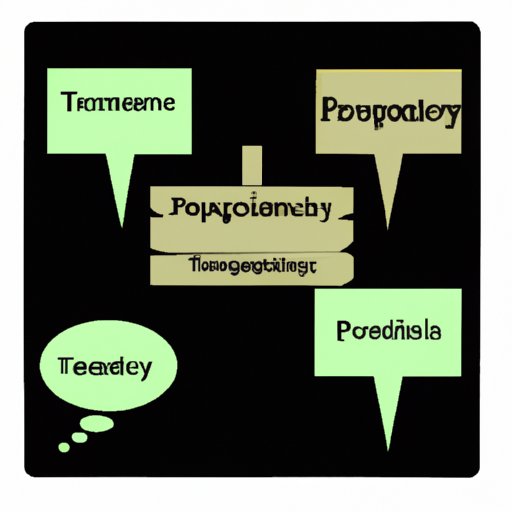Introduction
Technology is a term used to refer to the use of machines, computers, and other devices to enhance and improve human activities. It can be seen as both a blessing and a curse, depending on how it is used. In this article, we will explore the positive and negative impacts of technology on our lives, examining how it affects education, communication, and the environment.
Positive Impacts of Technology
There are many positive aspects of technology that have been beneficial to society. Some of these include improved education opportunities, enhanced communication, and increased efficiency. Let’s take a look at each one in more detail.
Improved Education Opportunities
Technology has had a major impact on education. According to a study conducted by the International Society for Technology in Education, technology has “enabled more flexible access to educational opportunities,” making it easier for students to learn from a variety of sources. Technology has also allowed for personalized learning, with students able to tailor their learning experience to their individual needs. This has enabled students to take control of their own learning and find new ways to engage with material.
Enhanced Communication
Technology has also had a significant impact on communication. With the advent of the internet, people are now able to connect with others around the world in an instant. This has made it much easier to stay in touch with family, friends, and colleagues, even if they live far away. Additionally, social media platforms such as Facebook, Twitter, and Instagram have made it easier than ever to share ideas and opinions with a wide audience.
Increased Efficiency
Finally, technology has led to increased efficiency in many areas. Automation and artificial intelligence have enabled businesses to streamline processes and reduce manual labor, increasing productivity and reducing costs. Additionally, the use of robots and other machines in manufacturing has allowed for faster production with fewer errors, resulting in higher quality products.
Negative Impacts of Technology
While technology has many benefits, there are some negative impacts as well. These include loss of privacy, potential for addiction, and increased inequality. Let’s look at each one in more detail.
Loss of Privacy
The use of technology has led to a decrease in privacy. With the rise of social media and other online platforms, personal information is now readily available to anyone who has access to the internet. Furthermore, websites and apps often collect user data and sell it to third parties, which can be used for targeted advertising or other purposes. As a result, it is becoming increasingly difficult to maintain privacy in the digital age.
Potential for Addiction
Another negative impact of technology is the potential for addiction. With so much of our lives now taking place online, it can be easy to become addicted to our phones, computers, and other devices. This can lead to decreased productivity, decreased focus, and even physical health problems. It is important to be aware of the dangers of technology addiction and take steps to prevent it.
Increased Inequality
Finally, technology has led to increased inequality. While technology has been beneficial to many, it has also created a divide between those who have access to it and those who do not. This can lead to unequal opportunities, with those who lack access to technology being left behind. Additionally, the use of automation and artificial intelligence has led to job losses, further exacerbating economic inequality.

Impact of Technology on Education
Technology has had a major impact on education. The use of computers, tablets, and other digital devices has allowed for improved access to educational resources, increased use of online learning, and increased student engagement. According to a survey conducted by the National Center for Education Statistics, 95% of teachers reported that technology had a “positive effect” on their students’ learning.
Improved Access to Educational Resources
One of the most significant impacts of technology on education has been improved access to educational resources. With the internet, students are now able to access a wealth of information and resources that were previously unavailable. This has enabled students to learn more effectively and efficiently, allowing them to gain a deeper understanding of material.
Increased Use of Online Learning
In addition to improved access to resources, technology has also enabled increased use of online learning. This has allowed students to take classes and complete coursework remotely, making it easier for them to pursue their educational goals. Additionally, online learning has enabled students to learn at their own pace, giving them the flexibility to tailor their learning experience to their individual needs.
Increase in Student Engagement
Finally, technology has also led to an increase in student engagement. With the use of digital devices, students are able to interact with material in a more engaging way. For example, they may be able to watch videos, use interactive tools, or participate in virtual activities, which can help them to better retain information.
Impact of Technology on Communication
Technology has also had a significant impact on communication. The use of the internet, smartphones, and other digital devices has enabled people to communicate quickly and easily, regardless of distance. Additionally, social media platforms have allowed people to share information and opinions with a wide audience.
Increased Speed and Ease of Communication
The primary benefit of technology on communication is increased speed and ease. With the internet, people are now able to contact each other almost instantly, no matter where they are in the world. Additionally, smartphones have made it possible to send messages, make calls, and share files quickly and conveniently.
Increased Access to Information
The use of technology has also enabled increased access to information. People are now able to find out about news, events, and other topics with just a few clicks of a button. Additionally, social media has allowed people to share their thoughts and opinions with a wide audience, enabling conversations on important issues.
Decreased Face-to-Face Interaction
However, there is also a downside to technology’s impact on communication. With the increased reliance on digital devices, face-to-face interaction has decreased significantly. This can lead to decreased empathy and decreased emotional connection, as people are less likely to pick up on nonverbal cues when communicating digitally.

Impact of Technology on the Environment
Technology has also had an impact on the environment. The increased use of computers, smartphones, and other devices has led to increased energy consumption and waste production, as well as increased air pollution.
Increased Energy Consumption
The use of technology has led to increased energy consumption, as digital devices require electricity to operate. Additionally, the production of these devices requires large amounts of energy, further contributing to energy consumption. According to the United Nations Environment Programme, the production of electronic devices is responsible for nearly 10% of global greenhouse gas emissions.
Increased Waste Production
The use of technology has also led to increased waste production. Electronic devices are typically discarded after a few years, leading to large amounts of e-waste. This waste contains toxic materials such as lead, mercury, and cadmium, which can be harmful to humans and the environment if not disposed of properly.
Increased Air Pollution
Finally, the production of technology has led to increased air pollution. The burning of fossil fuels to power manufacturing plants and other facilities has resulted in higher levels of air pollutants, such as carbon dioxide, nitrogen oxides, and sulfur dioxide. These pollutants can have serious health effects, including asthma and other respiratory illnesses.
Conclusion
In conclusion, technology has both positive and negative impacts on our lives. On the one hand, it has enabled improved access to educational resources, increased use of online learning, and increased speed and ease of communication. On the other hand, it has also led to a decrease in privacy, potential for addiction, and increased inequality. Additionally, the use of technology has had an impact on the environment, resulting in increased energy consumption, waste production, and air pollution. It is important to consider the impact of technology on society and take steps to ensure it is used responsibly.
(Note: Is this article not meeting your expectations? Do you have knowledge or insights to share? Unlock new opportunities and expand your reach by joining our authors team. Click Registration to join us and share your expertise with our readers.)
